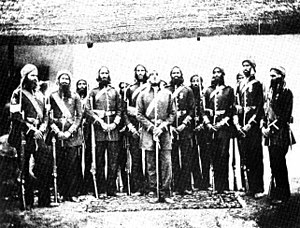| 15th Ludhiana Sikhs | |
|---|---|
 | |
| Active | 1846-1922 |
| Country | Indian Empire |
| Branch | Army |
| Type | Infantry |
| Part of | Bengal Army (to 1895) Bengal Command |
| Uniform | Red; faced green, 1905 emerald green |
| Engagements | 1861 - 62 China 1878 - 80 Afghanistan 1880 Ahmed Khel 1880 Kandahar 1885 Suakin Tofrek Chitral Punjab Frontier Tirah |
| Commanders | |
| Colonel-in-Chief | Edward VII (1904) |
The 15th Ludhiana Sikhs was an infantry regiment in the British Indian Army. They could trace their origins to 1846, when they were known as the Regiment of Ludhiana (or the Loodiana Regiment[1]). During the Indian Mutiny they were relied upon to hold Benares throughout the period of the Mutiny. In 1861, they became the 15th Bengal Native Infantry and shortly afterwards to the 15th (Ludhiana) Regiment of Bengal Native Infantry in 1864. Further changes in title followed they became the 15th Regiment of Bengal Native Infantry (Ludhiana Sikhs) in 1885, the 15th (Ludhiana) Sikh Infantry in 1901 and the 15th Ludhiana Sikhs following the Kitchener reforms of the Indian Army in 1903. To honour the visit of the Prince and Princess of Wales to Indian they took part in the Rawalpindi Parade 1905.

During this time they took part in the Battle of Ahmed Khel and the Battle of Kandahar in the Second Anglo-Afghan War. They then took part in the Battle of Tofrek and Suakin in the Mahdist War, the Chitral Expedition and the Tirah Campaign and World War I. During World War I they were part of the 8th (Jullundur) Brigade, 3rd (Lahore) Division they served on the Western Front in France, in Egypt as part of the Western Frontier Force, and in the Mesopotamia Campaign.[2]
After World War I the Indian government reformed the army again moving from single battalion regiments to multi battalion regiments.[3] The 15th Ludhiana Sikhs now became the 2nd Battalion, 11th Sikh Regiment. This regiment was later allocated to the new Indian Army after independence.

- ^ "No. 22176". The London Gazette. 24 August 1858. p. 3903.
- ^ "British Empire: Armed Forces: Units: Indian Infantry: 15th Sikhs". Archived from the original on 7 December 2009. Retrieved 2009-09-22.
- ^ Sumner p.15